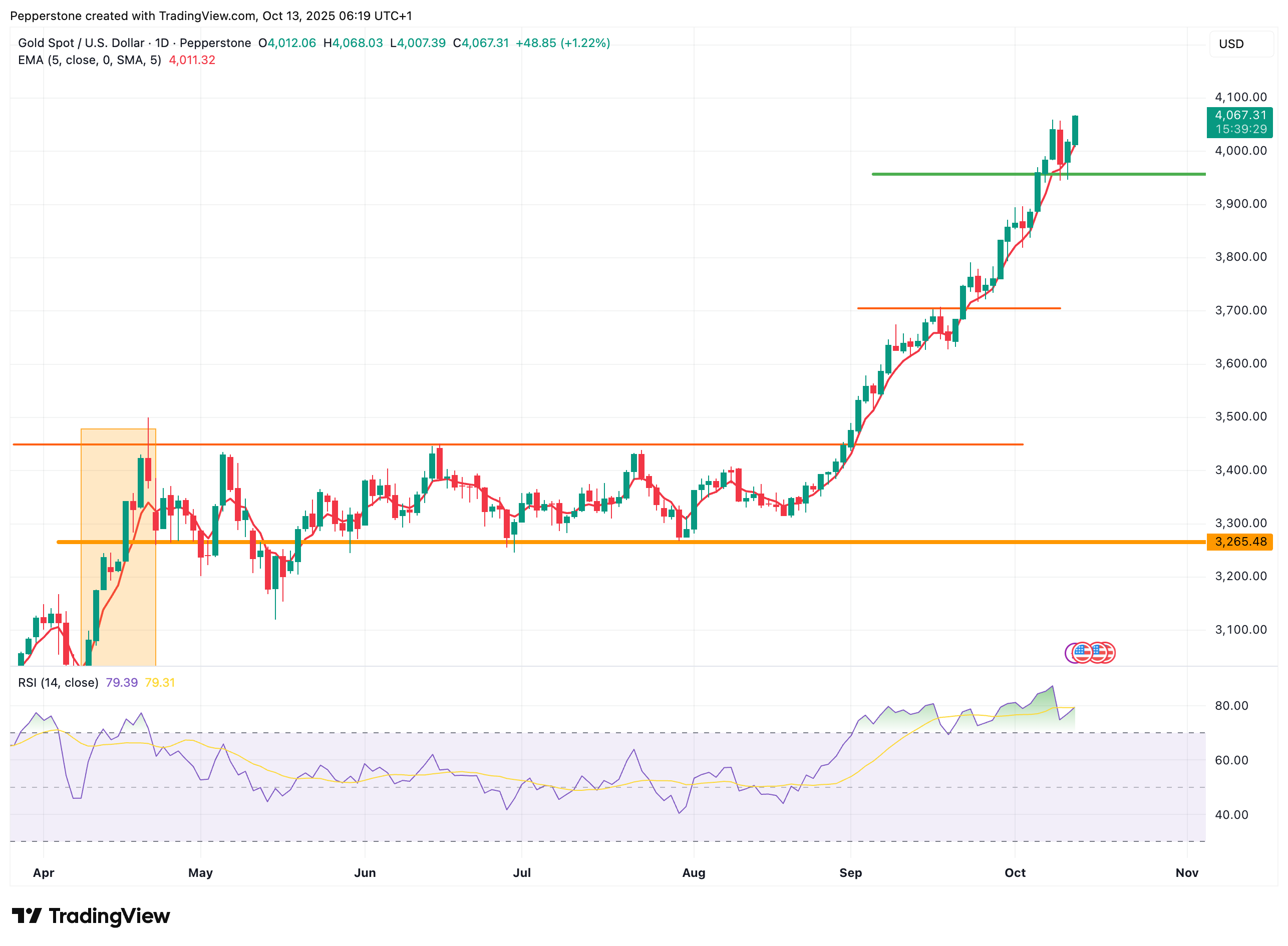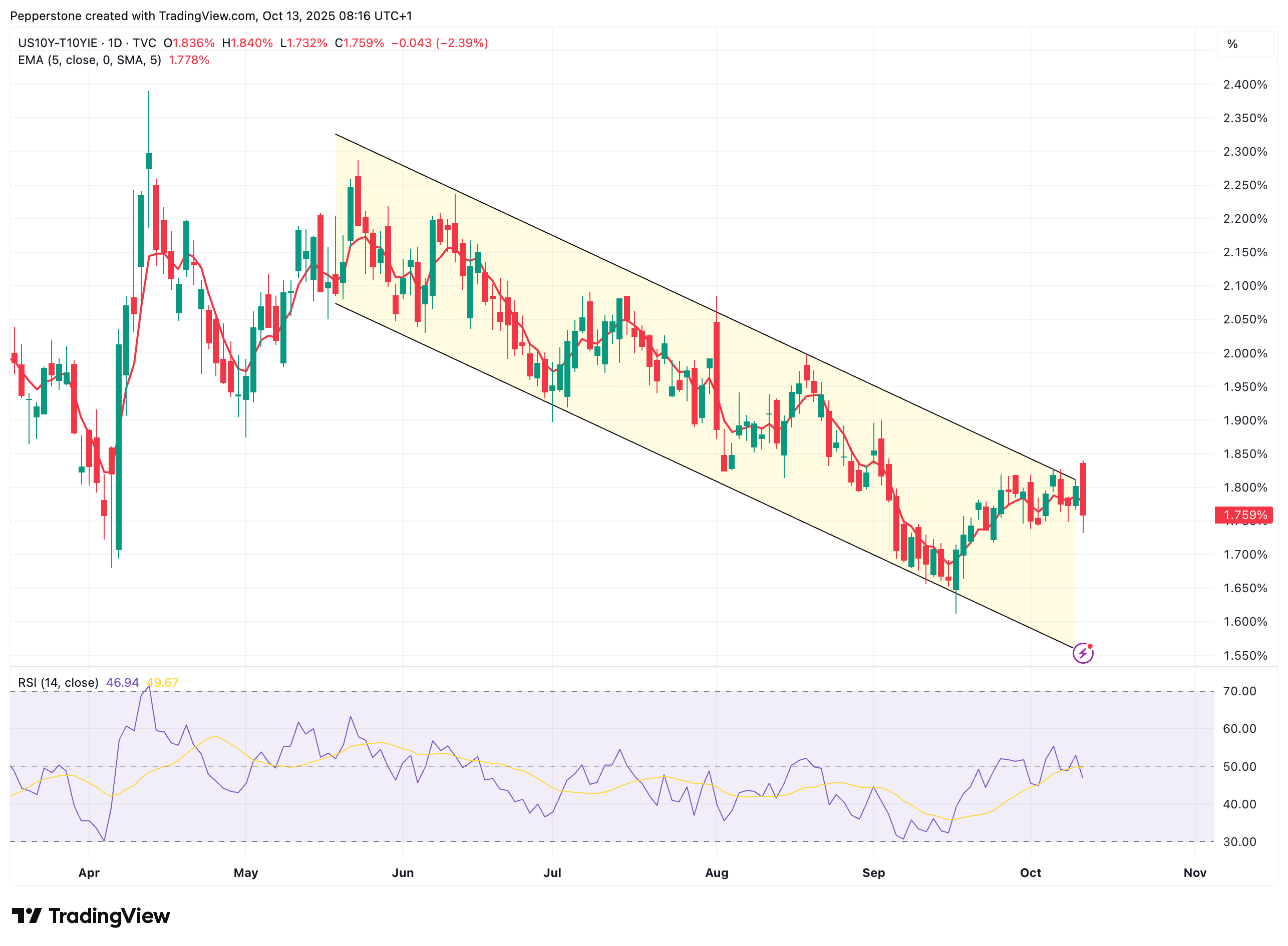CFDs are complex instruments and come with a high risk of losing money rapidly due to leverage. 80% of retail investor accounts lose money when trading CFDs with this provider. You should consider whether you understand how CFDs work and whether you can afford to take the high risk of losing your money.
- English
- 简体中文
- 繁体中文
- ไทย
- Tiếng Việt
- Español
- Português
- لغة عربية
Gold Outlook: Price Breaks $4,000 as Tariffs and Shutdown Boost Safe-Haven Demand
.jpg)
Over the past week, gold continued to extend its gains above the historic $4,000 level, with bulls maintaining a strong grip. The market has been propelled by multiple forces: safe-haven demand sparked by Trump’s threats of US-China tariffs, firm expectations of two Fed rate cuts this year, and political uncertainty stemming from the US government shutdown.
This week, aside from scattered macro releases such as US retail sales, policy developments remain the key driver of market sentiment and gold price dynamics.
Technical Observation: Consolidation Signal Amid Strength
On the XAUUSD daily chart, the overall uptrend remains intact. Although a technical pullback occurred last Thursday, with prices briefly dipping below $4,000, support at $3,955 held firm. After eight consecutive weeks of gains, gold is now hovering around $4,070.
A signal worth noting: strong bullish momentum has kept the RSI in overbought territory, but a clear bearish divergence is now visible on the chart, suggesting the market is accumulating technical adjustment pressure.

Looking ahead, $4,050 will be a key level. A firm hold above this point could pave the way toward $4,100 or higher. Conversely, if resistance holds, gold may consolidate between $3,955 and $4,050 to digest recent gains.
Escalating Tariff Tensions and Government Shutdown Concerns
Although the recent Israel-Hamas ceasefire brought some positive developments, prompting partial unwinding of safe-haven positions, gold’s brief dip was quickly seen as a buying opportunity. The sustained demand reflects a combination of factors: the new round of US-China tariff tensions, Fed rate cut expectations, and ongoing uncertainty over the US economic outlook.
Trade and political uncertainty have become fresh catalysts for safe-haven demand. Trump announced a 100% tariff on Chinese goods effective November 1, accompanied by controls on key software exports, sharply escalating global trade tensions. Although he later signaled some softening on social media, the unpredictability has further clouded the visibility of tariff policy.
In response, China imposed controls on key exports to the US, including lithium batteries and rare earths, signaling that trade frictions are spreading to more critical sectors. Coupled with prior White House tariff proposals on pharmaceuticals, bathroom products, and trucks, traders have revisited gold’s safe-haven appeal.
US fiscal and debt concerns continue to grow. The government shutdown has entered its second week, and warnings from White House economic advisors about potential “layoffs” have prompted the market to price in the economic impact of a prolonged shutdown.
Meanwhile, political turmoil in France over budget issues, alongside Japan’s new leadership potentially pursuing expansionary fiscal policies, has heightened concerns over debt expansion and lax fiscal discipline in developed economies. In this environment, sovereign credit currencies lose some of their appeal, further highlighting gold’s role as a hedge against currency depreciation.
Complex Geopolitics and Two Rate-Cut Bets
Compared with rising trade tensions and elevated US debt levels, geopolitical risks remain complex and volatile. On one hand, the Middle East achieved a temporary ceasefire through diplomatic mediation, easing some risk. On the other, the Russia-Ukraine conflict has escalated, with warnings issued over potential US “Tomahawk” missile support, indicating that high-level geopolitical tension remains, supporting gold prices.
Beyond these safe-haven drivers, monetary policy expectations underpin gold’s broader uptrend. The New York Fed’s September report showed one-year inflation expectations rising to 3.38%, a five-month high, while the University of Michigan consumer sentiment slipped to near lows last seen during the high inflation period of 2021.
This combination of “inflation resilience” and “confidence weakness” reflects heightened public concern over the economic outlook amid government shutdowns, slowing employment growth, and persistent price pressures.
Despite inflationary risks, in the context of high fiscal deficits and a weak labor market, the market has fully priced in 25-basis-point Fed cuts in both October and December. The combination of rate cuts and elevated inflation expectations keeps 10-year real US Treasury yields near 1.76%, a relatively low level. For zero-yield assets like gold, lower real rates reduce holding costs and attract buying interest.

High-Level Resilience Continues; Focus on Tariffs and Political Gridlock
Overall, gold demonstrated clear resilience at high levels last week. International trade tensions, complex geopolitical signals, steady Fed rate-cut expectations, and political turmoil across multiple countries have sustained strong safe-haven demand while lowering the opportunity cost of holding gold. Recent technical pullbacks appear to be healthy consolidation within a broader uptrend, rather than a trend reversal, providing a solid foundation for the medium-term outlook.
In the coming week, besides monitoring the US government shutdown, market attention will remain on political gridlock developments and any policy signals from the Fed.
With some economic data delayed due to the shutdown, the New York and Philadelphia Fed manufacturing reports, along with Fed Chair Powell’s Tuesday speech, will be critical in assessing economic conditions and policy direction. Additionally, the IMF and World Bank annual meetings may convey important global policy cues. If manufacturing data remain weak and Powell maintains a dovish stance, gold could gain fresh support and edge higher.
Meanwhile, progress in US-China tariff negotiations also warrants close attention. If tariff threats are ultimately more strategic than substantive, safe-haven buying in gold could ease. However, if these measures are fully implemented, rising costs for Chinese exporters and pressure on corporate profits could trigger new volatility in global risk assets, significantly enhancing gold’s safe-haven appeal.
The material provided here has not been prepared in accordance with legal requirements designed to promote the independence of investment research and as such is considered to be a marketing communication. Whilst it is not subject to any prohibition on dealing ahead of the dissemination of investment research we will not seek to take any advantage before providing it to our clients. Pepperstone doesn’t represent that the material provided here is accurate, current or complete, and therefore shouldn’t be relied upon as such. The information, whether from a third party or not, isn’t to be considered as a recommendation; or an offer to buy or sell; or the solicitation of an offer to buy or sell any security, financial product or instrument; or to participate in any particular trading strategy. It does not take into account readers’ financial situation or investment objectives. We advise any readers of this content to seek their own advice. Without the approval of Pepperstone, reproduction or redistribution of this information isn’t permitted.